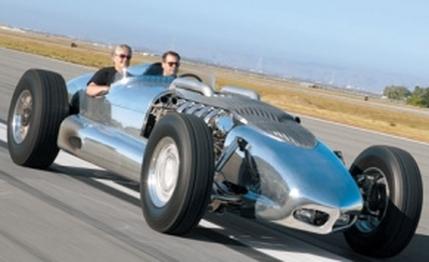
 Specialty File
Specialty File
One minute and 29 seconds. As a quarter-mile time, it's pretty slack. As the time it takes for the Blastolene Indy Special to cause hearing damage, it's pretty fearsome. Accelerating up to freeway speeds, the Blastolene pummels driver and passenger with a 110-decibel sonic baseball bat. At that noise level, workmen's-comp claims could start flowing in less than two minutes, according to a hearing damage formula developed by the National Institute for Occupational Safety and Health (NIOSH).
Merely idling, the Blastolene registers 96 decibels with its bellowing side pipes, from which the NIOSH nabobs advise you to flee after 37 minutes and 48 seconds. And you think a Harley is antisocial?
The Blastolene Indy Special isn't the first hot rod of its ilk. Carbuilder Randy Grubb, a glass artist from Grants Pass, Oregon, built the first aluminum-bodied Blastolene Special out of homemade bits and junkyard truck parts in 2002. He quickly sold it to television comedian Jay Leno. Besides being 21 feet long, weighing in at 8900 pounds, running on shaved Goodyear garbage-truck tires, and using an air-cooled 1792-cubic-inch, 810-hp V-12 originally designed for an M47 Patton tank, Leno's car is fairly conventional.
In 2004 we drag-raced Leno's rod with a genuine 68-ton M1A1 Abrams tank. The Abrams was pitifully slower, but it could have won simply by eliminating Leno from behind, with its 120mm main gun ("Tank vs. Crank,"). Apparently, the Army didn't think of that.
Dennis Gibbs, 62, is relatively soft spoken. He lists his occupations as real estate, banking, wind turbines, philanthropy, and early retirement. Gibbs had tried to buy the first Blastolene. When that didn't pan out, he took dibs on a second, similar car being constructed by Grubb around the same 2000-pound Continental AV-1790-5B tank engine but with different bodywork. Whereas Leno's looks like a supersized Bonneville lakester, Blastolene No. 2 is a sort of 19/10ths-scale model of the shark-shaped Watson roadsters that ran at Indianapolis in the 1950s and early '60s.
"I just liked the aesthetics and the craftsmanship," says Gibbs, who, like Leno, keeps a barn or two full of classic cars. Gibbs also liked the Blastolene concept. What is Blastolene? "A highly concentrated distillation of pure cozmic [ sic] essence...an 'attitudinal conditioner'...like opening a can of 'whuppass,'?" extols www.blastolene.com. In short, it's hooey, a figment of Grubb's goofy humor. Leno, by the way, just calls his vehicle "the tank car."
We're at San Francisco's Moffett Field, a former Navy blimp base not far from Gibbs's home to the east in Castro Valley. Some string pulling has resulted in permission to make a few head-splitting passes on the runway in the Blastolene. The car comes in on a rollback. Gibbs turns the levers to activate the quad magnetos and then hits the start button. The Blastolene's AV-1790 becomes an atom smasher of noise, from the deep artillery concussion of the exhaust to the ravenous suck of the toaster-sized carbs to the whirring of the two huge crank-driven cooling fans. Gibbs yells over the banshee racket that the car indeed has mufflers. "Flowmasters, I think!" Who can tell if he's fibbing? The pipes run behind the naked hand-rolled aluminum bodywork to exit just below but seemingly directly into your ears. It's hard to imagine a car powered by sticks of dynamite being any louder.
Gibbs takes the wheel first, and we pull onto the runway. Some lessons learned on Leno's car have been incorporated into this one, including the use of power brakes, air springs on both of the huge floating axles, and side braces to keep the frame's trailing-arm pivots from bending under the loads. With 1560 pound-feet of torque to swallow, the four-speed Allison bus transmission won't take much brake-torquing. Following a couple of tentative passes, Gibbs gives it the full squirt.
The clatter is brain rattling, the ride choppy on the sectioned concrete, the heat exhausted upward by the cooling fans like a furnace blast into our faces. The upshift at 2800 rpm is as smooth as two box cars banging together. The airport fire engine serving as our escort rapidly drops behind. We roar past 60 mph in 7.7 seconds sounding like a Lockheed Constellation on takeoff. We thunder through the quarter-mile in 15.9 seconds at 90 mph sounding like two Lockheed Constellations crashing. With the dial showing 120 mph and our hair blown back into a couple of teardrops, Gibbs gets off the gas.
" Whoa! One-twenty!" he shouts. "That was pretty amazing!" I'll break the news later that our VBOX put the run's top speed at just 106. Never mind, it was amazing...and terrifying, and everything a $350,000 car should be.
I slip behind the steering wheel. As in Leno's car, the cockpit is bizarrely snug and the luggage capacity is about spent with a cell phone, but there's more room to move feet around. The steering is numb and the responses as slow as a four-ton Buick's. A few maneuvers show that stops from 70 mph in less than 400 feet are indeed possible, but the car gets squirrelly (well, more like grizzly) under hard braking, and Gibbs is reluctant to push it.
Merging onto a packed freeway for the short drive to the photo studio, the Blastolene rattles the windows of surrounding vehicles, fellow drivers staring at us. We look like two superheroes heading out to save the planet, but it's hard to tell what we're doing faster: going deaf, cooking alive, or asphyxiating on the fumes. Gibbs looks over and puts into words something I had assumed all along.
"I don't drive it much."